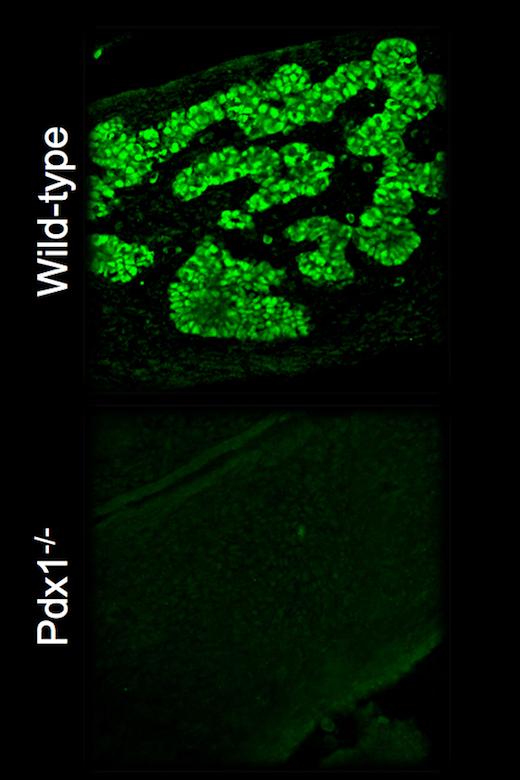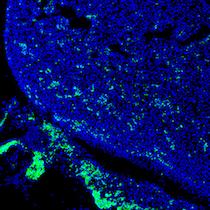A holy grail for regenerative medicine is to grow entire body parts for patients in the laboratory as replacements for damaged or failing organs. We seek to grow human organs inside of animals via interspecies chimera formation.
CRISPR-Cas9 mediated zygote genome editing efficiently knocks out PDX1 from a 4-week old pig fetus. Top, wild type control. Bottom, PDX1-/-. Green immunostaining indicates PDX1 expression.
One obstacle is that cells in a chimera randomly differentiate into various tissues. In order to force donor pluripotent stem cells (PSCs) to produce a specific organ, one must disable the host gene(s) critical for that particular organ's development, to empty the developmental niche for donor PSCs to populate. Proof-of-concept studies in rodents have clearly indicated that the organs generated via interspecies blastocyst complementation are just as functional as those from wild-type animals.
We have combined this method with CRISPR-Cas9-mediated zygote genome editing to create a versatile and efficient system[1], and are in the early stages of using pig embryos as hosts for human organs. We have successfully knocked out PDX1, a critical gene in pancreas development, in a promising step toward growing a human pancreas [2].
Human iPSCs (green) contributed to a 4-week-old pig fetus. Blue DAPI staining indicates pig cells.
However, we have come against a serious obstacle: human-pig chimeras consist mostly of porcine cells, so we must develop novel strategies to understand and overcome the xeno-barriers between primate and ungulate species. Ultimately, we aim to create functional, transplantable human organs using animal hosts.
References
- Wu J, Platero-Luengo A, Sakurai M, Sugawara A, Gil MA, Yamauchi T, et al. (2017) Interspecies Chimerism with Mammalian Pluripotent Stem Cells. Cell.168: 473–486.e15.
- Wu J*, Vilariño M*, Suzuki K*, Okamura D, Bogliotti YS, Park I, et al. (2017) CRISPR-Cas9 mediated one-step disabling of pancreatogenesis in pigs. Scientific Reports. 7: 10487.
* Co-first authors
 CRISPR-Cas9 mediated zygote genome editing efficiently knocks out PDX1 from a 4-week old pig fetus. Top, wild type control. Bottom, PDX1-/-. Green immunostaining indicates PDX1 expression.
CRISPR-Cas9 mediated zygote genome editing efficiently knocks out PDX1 from a 4-week old pig fetus. Top, wild type control. Bottom, PDX1-/-. Green immunostaining indicates PDX1 expression.  Human iPSCs (green) contributed to a 4-week-old pig fetus. Blue DAPI staining indicates pig cells.
Human iPSCs (green) contributed to a 4-week-old pig fetus. Blue DAPI staining indicates pig cells.